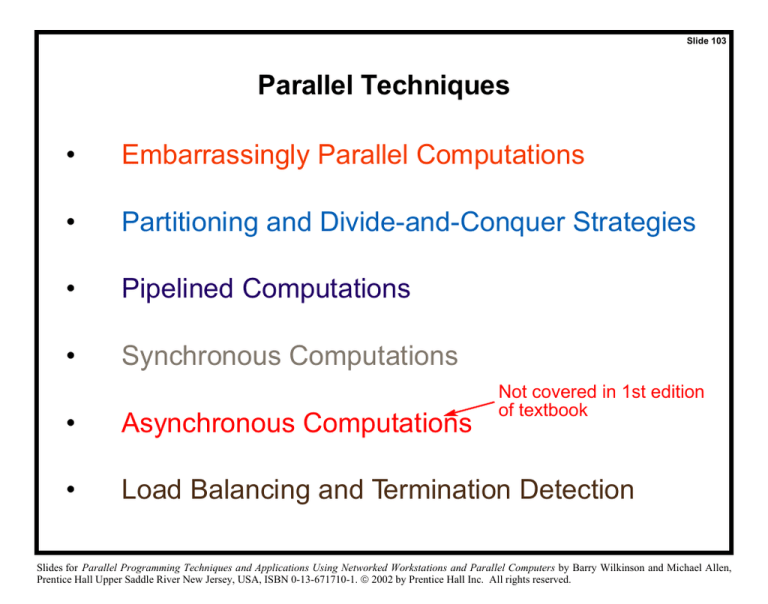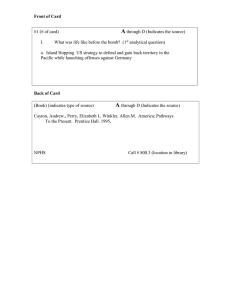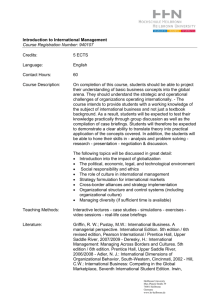
Slide 103
Parallel Techniques
•
Embarrassingly Parallel Computations
•
Partitioning and Divide-and-Conquer Strategies
•
Pipelined Computations
•
Synchronous Computations
Not covered in 1st edition
of textbook
•
Asynchronous Computations
•
Load Balancing and Termination Detection
Slides for Parallel Programming Techniques and Applications Using Networked Workstations and Parallel Computers by Barry Wilkinson and Michael Allen,
Prentice Hall Upper Saddle River New Jersey, USA, ISBN 0-13-671710-1. 2002 by Prentice Hall Inc. All rights reserved.
Slide 104
Chapter 3
Embarrassingly Parallel Computations
Slides for Parallel Programming Techniques and Applications Using Networked Workstations and Parallel Computers by Barry Wilkinson and Michael Allen,
Prentice Hall Upper Saddle River New Jersey, USA, ISBN 0-13-671710-1. 2002 by Prentice Hall Inc. All rights reserved.
Slide 105
Embarrassingly Parallel Computations
A computation that can obviously be divided into a number of
completely independent parts, each of which can be executed by a
separate process(or).
Input data
Processes
Results
No communication or very little communication between processes
Each process can do its tasks without any interaction with other processes
Slides for Parallel Programming Techniques and Applications Using Networked Workstations and Parallel Computers by Barry Wilkinson and Michael Allen,
Prentice Hall Upper Saddle River New Jersey, USA, ISBN 0-13-671710-1. 2002 by Prentice Hall Inc. All rights reserved.
Slide 106
Practical embarrassingly parallel computation
with static process creation and master-slave
approach
All processes
started together
Send initial data
Slaves
send()
recv()
Master
send()
recv()
Collect results
MPI approach
Slides for Parallel Programming Techniques and Applications Using Networked Workstations and Parallel Computers by Barry Wilkinson and Michael Allen,
Prentice Hall Upper Saddle River New Jersey, USA, ISBN 0-13-671710-1. 2002 by Prentice Hall Inc. All rights reserved.
Slide 107
Practical embarrassingly parallel computation
with dynamic process creation and master-slave
approach
Start Master initially
spawn()
send()
Send initial data
Slaves
recv()
Master
send()
recv()
Collect results
PVM approach
Slides for Parallel Programming Techniques and Applications Using Networked Workstations and Parallel Computers by Barry Wilkinson and Michael Allen,
Prentice Hall Upper Saddle River New Jersey, USA, ISBN 0-13-671710-1. 2002 by Prentice Hall Inc. All rights reserved.
Slide 108
Embarrassingly Parallel Computation Examples
• Low level image processing
• Mandelbrot set
• Monte Carlo Calculations
Slides for Parallel Programming Techniques and Applications Using Networked Workstations and Parallel Computers by Barry Wilkinson and Michael Allen,
Prentice Hall Upper Saddle River New Jersey, USA, ISBN 0-13-671710-1. 2002 by Prentice Hall Inc. All rights reserved.
Slide 109
Low level image processing
Many low level image processing operations only involve local data
with very limited if any communication between areas of interest.
Slides for Parallel Programming Techniques and Applications Using Networked Workstations and Parallel Computers by Barry Wilkinson and Michael Allen,
Prentice Hall Upper Saddle River New Jersey, USA, ISBN 0-13-671710-1. 2002 by Prentice Hall Inc. All rights reserved.
Slide 110
Partitioning into regions for individual
processes.
x
Process
80
640
y
80
Map
480
Square region for each process (can also use strips)
Slides for Parallel Programming Techniques and Applications Using Networked Workstations and Parallel Computers by Barry Wilkinson and Michael Allen,
Prentice Hall Upper Saddle River New Jersey, USA, ISBN 0-13-671710-1. 2002 by Prentice Hall Inc. All rights reserved.
Slide 111
Some geometrical operations
Shifting
Object shifted by ∆x in the x-dimension and ∆y in the y-dimension:
x′ = x + ∆x
y′ = y + ∆y
where x and y are the original and x′ and y′ are the new coordinates.
Scaling
Object scaled by a factor Sx in x-direction and Sy in y-direction:
x′ = xSx
y′ = ySy
Rotation
Object rotated through an angle θ about the origin of the coordinate
system:
x′ = x cos θ + y sin θ
y′ = −x sin θ + y cos θ
Slides for Parallel Programming Techniques and Applications Using Networked Workstations and Parallel Computers by Barry Wilkinson and Michael Allen,
Prentice Hall Upper Saddle River New Jersey, USA, ISBN 0-13-671710-1. 2002 by Prentice Hall Inc. All rights reserved.
Slide 112
Mandelbrot Set
Set of points in a complex plane that are quasi-stable (will increase
and decrease, but not exceed some limit) when computed by
iterating the function
zk+1 = zk2 + c
where zk+1 is the (k + 1)th iteration of the complex number z = a + bi
and c is a complex number giving position of point in the complex
plane. The initial value for z is zero.
Iterations continued until magnitude of z is greater than 2 or number
of iterations reaches arbitrary limit. Magnitude of z is the length of
the vector given by
zlength =
2
a +b
2
Slides for Parallel Programming Techniques and Applications Using Networked Workstations and Parallel Computers by Barry Wilkinson and Michael Allen,
Prentice Hall Upper Saddle River New Jersey, USA, ISBN 0-13-671710-1. 2002 by Prentice Hall Inc. All rights reserved.
Slide 113
Sequential routine computing value of one point returning
number of iterations
structure complex {
float real;
float imag;
};
int cal_pixel(complex c)
{
int count, max;
complex z;
float temp, lengthsq;
max = 256;
z.real = 0; z.imag = 0;
count = 0;
/* number of iterations */
do {
temp = z.real * z.real - z.imag * z.imag + c.real;
z.imag = 2 * z.real * z.imag + c.imag;
z.real = temp;
lengthsq = z.real * z.real + z.imag * z.imag;
count++;
} while ((lengthsq < 4.0) && (count < max));
return count;
}
Slides for Parallel Programming Techniques and Applications Using Networked Workstations and Parallel Computers by Barry Wilkinson and Michael Allen,
Prentice Hall Upper Saddle River New Jersey, USA, ISBN 0-13-671710-1. 2002 by Prentice Hall Inc. All rights reserved.
Slide 114
Mandelbrot set
Imaginary
+2
0
-2
-2
0
+2 Real
Slides for Parallel Programming Techniques and Applications Using Networked Workstations and Parallel Computers by Barry Wilkinson and Michael Allen,
Prentice Hall Upper Saddle River New Jersey, USA, ISBN 0-13-671710-1. 2002 by Prentice Hall Inc. All rights reserved.
Slide 115
Parallelizing Mandelbrot Set Computation
Static Task Assignment
Simply divide the region in to fixed number of parts, each computed
by a separate processor.
Not very successful because different regions require different
numbers of iterations and time.
Dynamic Task Assignment
Have processor request regions after computing previous regions
Slides for Parallel Programming Techniques and Applications Using Networked Workstations and Parallel Computers by Barry Wilkinson and Michael Allen,
Prentice Hall Upper Saddle River New Jersey, USA, ISBN 0-13-671710-1. 2002 by Prentice Hall Inc. All rights reserved.
Slide 116
Dynamic Task Assignment
Work Pool/Processor Farms
Work pool
(xc, yc)
(xa, ya)
(xb, yb)
(xe, ye)
(xd, yd)
Task
Return results/
request new task
Slides for Parallel Programming Techniques and Applications Using Networked Workstations and Parallel Computers by Barry Wilkinson and Michael Allen,
Prentice Hall Upper Saddle River New Jersey, USA, ISBN 0-13-671710-1. 2002 by Prentice Hall Inc. All rights reserved.
Slide 117
Monte Carlo Methods
Another embarrassingly parallel computation.
Monte Carlo methods use of random selections.
Slides for Parallel Programming Techniques and Applications Using Networked Workstations and Parallel Computers by Barry Wilkinson and Michael Allen,
Prentice Hall Upper Saddle River New Jersey, USA, ISBN 0-13-671710-1. 2002 by Prentice Hall Inc. All rights reserved.
Slide 118
Example - To calculate π
Circle formed within a square, with unit radius so that square has
sides 2 × 2. Ratio of the area of the circle to the square given by
Area of circle- = π
( 1 )2 = π
------------------------------------------------4
Area of square
2×2
Points within square chosen randomly.
Score kept of how many points happen to lie within circle.
Fraction of points within the circle will be π/4, given a sufficient
number of randomly selected samples.
Slides for Parallel Programming Techniques and Applications Using Networked Workstations and Parallel Computers by Barry Wilkinson and Michael Allen,
Prentice Hall Upper Saddle River New Jersey, USA, ISBN 0-13-671710-1. 2002 by Prentice Hall Inc. All rights reserved.
Slide 119
Total area = 4
2
Area = π
2
Slides for Parallel Programming Techniques and Applications Using Networked Workstations and Parallel Computers by Barry Wilkinson and Michael Allen,
Prentice Hall Upper Saddle River New Jersey, USA, ISBN 0-13-671710-1. 2002 by Prentice Hall Inc. All rights reserved.
Slide 120
Computing an Integral
One quadrant of the construction can be described by integral
1 1 – x 2 dx = π
--4
Random pairs of numbers, (xr ,yr) generated, each between 0 and 1.
∫0
Counted as in circle if y r ≤ 1 – x r2 ; that is, y r2 + x r2 ≤ 1 .
1
f(x)
y =
1
1 – x2
x
1
Slides for Parallel Programming Techniques and Applications Using Networked Workstations and Parallel Computers by Barry Wilkinson and Michael Allen,
Prentice Hall Upper Saddle River New Jersey, USA, ISBN 0-13-671710-1. 2002 by Prentice Hall Inc. All rights reserved.
Slide 121
Alternative (better) Method
Use random values of x to compute f(x) and sum values of f(x):
N
x2
1
Area = ∫ f ( x ) dx = lim ---- ∑ f ( x r ) ( x 2 – x 1 )
x1
N → ∞N i = 1
where xr are randomly generated values of x between x1 and x2.
Monte Carlo method very useful if the function cannot be integrated
numerically (maybe having a large number of variables)
Slides for Parallel Programming Techniques and Applications Using Networked Workstations and Parallel Computers by Barry Wilkinson and Michael Allen,
Prentice Hall Upper Saddle River New Jersey, USA, ISBN 0-13-671710-1. 2002 by Prentice Hall Inc. All rights reserved.
Slide 122
Example
Computing the integral
I =
x2 2
∫ x ( x – 3x ) dx
1
Sequential Code
sum = 0;
for (i = 0; i < N; i++) { /* N random samples */
xr = rand_v(x1, x2);
/* generate next random value */
sum = sum + xr * xr - 3 * xr;
/* compute f(xr) */
}
area = (sum / N) * (x2 - x1);
Routine randv(x1, x2) returns a pseudorandom number between x1
and x2.
Slides for Parallel Programming Techniques and Applications Using Networked Workstations and Parallel Computers by Barry Wilkinson and Michael Allen,
Prentice Hall Upper Saddle River New Jersey, USA, ISBN 0-13-671710-1. 2002 by Prentice Hall Inc. All rights reserved.
Slide 123
For parallelizing Monte Carlo code, must address best way to
generate random numbers in parallel - see textbook
Slides for Parallel Programming Techniques and Applications Using Networked Workstations and Parallel Computers by Barry Wilkinson and Michael Allen,
Prentice Hall Upper Saddle River New Jersey, USA, ISBN 0-13-671710-1. 2002 by Prentice Hall Inc. All rights reserved.
Slide 124
Intentionally blank
Slides for Parallel Programming Techniques and Applications Using Networked Workstations and Parallel Computers by Barry Wilkinson and Michael Allen,
Prentice Hall Upper Saddle River New Jersey, USA, ISBN 0-13-671710-1. 2002 by Prentice Hall Inc. All rights reserved.


